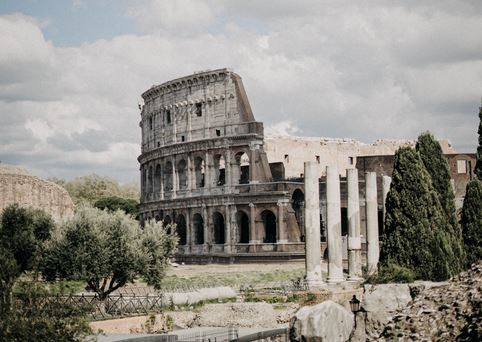Facts About Ancient Rome: A Captivating Civilization |

|
|
Photo by: Zach Dyson |
|
More Ancient Facts: Step back in time and immerse yourself in the grandeur of ancient Rome, a civilization that continues to captivate and influence our world today. From its mythical beginnings to its sprawling empire, Rome left an indelible mark on law, language, architecture, and culture. Prepare to uncover twelve fascinating glimpses into this remarkable society, revealing surprising facts and enduring legacies that shaped the course of Western history. The Legendary FoundingAccording to Roman mythology, the city of Rome was founded in 753 BCE by the twin brothers Romulus and Remus. This legendary tale, often recounted in Roman literature, adds a mythical aura to the origins of one of history's most influential civilizations. You can learn more about the myth of Romulus and Remus at Britannica. Engineering Marvels: AqueductsThe Romans were exceptional engineers, and their aqueducts are a testament to this. These impressive structures transported vast amounts of water to Roman cities, supporting public baths, fountains, and private households. The Pont du Gard in France is a stunning example of Roman aqueduct engineering. The Colosseum: An Entertainment HubThe Colosseum, also known as the Flavian Amphitheatre, was an iconic entertainment venue in ancient Rome. It hosted gladiatorial contests, public spectacles, and even mock sea battles, drawing massive crowds. Discover more about the history of the Colosseum on History.com. A Powerful Military MachineThe Roman legions were a highly disciplined and effective military force. Their organization, tactics, and engineering capabilities allowed Rome to conquer and control a vast empire. Understanding the structure of the Roman legion is key to understanding their success. Latin: The Lingua FrancaLatin, the language of ancient Rome, became the lingua franca of the Western world for centuries. It influenced numerous modern languages and continues to be studied today. Many English words have Latin roots, as you can explore on the Online Etymology Dictionary. Public Baths: Social CentersRoman public baths were more than just places to get clean; they were important social hubs. People would gather to socialize, exercise, and conduct business. The Baths of Caracalla were among the most grand Roman bath complexes. Extensive Road NetworkThe Romans built an extensive network of roads that connected all parts of their empire. These roads facilitated trade, communication, and the movement of troops, famously saying, "All roads lead to Rome." Learn about the impact of Roman roads on Ancient History Encyclopedia. The Twelve Tables: Early Roman LawThe Twelve Tables was one of the earliest attempts to codify Roman law. Displayed publicly, these laws aimed to ensure a degree of fairness and transparency in the legal system. Understanding the Twelve Tables provides insight into early Roman society. Gladiatorial Combat: A Popular SpectacleGladiatorial combat was a popular and often brutal form of entertainment in ancient Rome. Gladiators, often slaves or criminals, fought each other or wild animals for the amusement of the crowds. Historical accounts detail the intense nature of gladiatorial contests. The Rise and Fall of EmperorsAncient Rome was ruled by emperors for centuries, from the powerful Augustus to the controversial Nero. The reigns of these emperors significantly shaped Roman history, marked by periods of peace and prosperity as well as turmoil and decline. Explore the era of Roman emperors on PBS. Pompeii: A City Frozen in TimeThe eruption of Mount Vesuvius in 79 AD tragically buried the Roman city of Pompeii under volcanic ash, preserving it in a remarkable state. Today, Pompeii offers a unique glimpse into daily life in ancient Rome. Discover the archaeological site of Pompeii. A Lasting LegacyThe legacy of ancient Rome is profound and far-reaching. Its contributions to law, language, architecture, engineering, and political thought continue to influence Western civilization. The impact of Rome can be seen in many aspects of modern life. Consider the influence on modern modern culture. Ancient Rome FAQsA few more questions you might need answered about ancient Rome. When did the Roman Empire exist?The traditional date for the founding of Rome is 753 BCE. The Roman Republic was established in 509 BCE, and the Roman Empire is generally considered to have begun with Emperor Augustus in 27 BCE. The Western Roman Empire fell in 476 CE, while the Eastern Roman Empire (Byzantine Empire) lasted until 1453 CE. What were some major Roman inventions?The Romans were innovative and developed many important technologies and infrastructure, including aqueducts, concrete, advanced road systems, sanitation systems, and the Julian calendar. What was Roman society like?Roman society was highly stratified, with a complex social hierarchy that included patricians (nobles), plebeians (commoners), and slaves. Family was central to Roman life, and public life revolved around politics, entertainment, and religious festivals. What caused the fall of the Roman Empire?The decline and fall of the Western Roman Empire was a complex process with multiple contributing factors, including political instability, economic problems, barbarian invasions, social decay, and the vast size of the empire making it difficult to govern. What is the lasting impact of ancient Rome?Ancient Rome's impact is immense. It shaped Western law, language (especially Latin-based languages), architecture, engineering, political thought (concepts like republic and senate), and even aspects of our calendar and alphabet. |